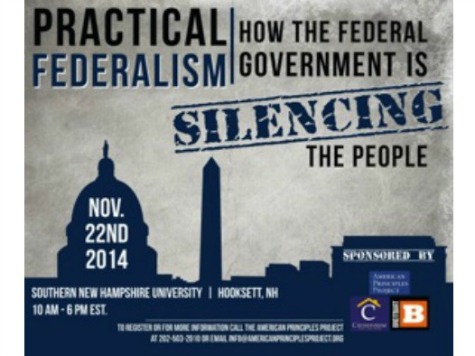Editor’s Note: Breitbart News Network, American Principles Project, and Cornerstone Action are co-sponsors of an upcoming forum centered on the principles of federalism. More information about the forum can be found at Cornerstone, American Principles Project, and Breitbart News.
More than any other event in the last fifty years, the advent of Obamacare has reignited a debate over the proper relationship between the federal government and the states.
This probably isn’t what Obama administration officials were hoping for when Congressional Democrats passed the sweeping healthcare law in 2010, but they should have seen it coming. By relying on states to implement major provisions of the Affordable Care Act, like the Medicaid expansion and the creation of health insurance exchanges, the White House opened the door to state resistance and a debate over federalism.
Before Obamacare, federalism wasn’t something we talked about much, in part because so much power and policymaking have consolidated in Washington, D.C., over the years. But that’s not how our Republic was originally designed. As James Madison explained in Federalist 45, the powers of the federal government were to be “few and defined… most extensive and important in times of war and danger; those of the State governments, in times of peace and security.”
The idea, animated by our Founders’ wariness of centralized power, was that the states and the federal government were to have separate, sovereign spheres, and that federal powers were to be enumerated, thus placing structural limits on what it could do.
The Supreme Court’s 2012 ruling in NFIB v. Sebelius revived the question of federalism in an unexpected way. Before the ruling, most observers speculated about how the court would rule on the individual mandate. Could commerce clause jurisprudence be extended to compel individuals to engage in commerce by buying health insurance? In the end, the Court dodged that question by ruling the mandate’s penalty a “tax.” The real shock was how the Court interpreted Obamacare’s mandatory Medicaid expansion.
As written, the ACA compelled states to expand their Medicaid programs to include non-disabled adults up to 138 percent of the federal poverty level. If not, they would lose all their federal Medicaid funding. But Chief Justice John Roberts found the Medicaid expansion was “a gun to the head”–an unconstitutional coercion of the states by the federal government, and a violation of the principle of federalism.
And yet compelling states to administer federal programs is precisely what Obamacare attempted to do through its expansion of Medicaid. Although technically run by state agencies, the federal Centers for Medicare and Medicaid Services (CMS) promulgates copious rules for Medicaid, all of which the state must adhere to or risk losing federal funds. Forcing states to expand would have made their already weak position worse.
States, after all, rely on those federal Medicaid funds, which can run into the tens of billions for larger states like California and Texas. For every dollar a state spends on Medicaid, the feds reimburse it about 60 cents, depending on the state (some get more, some less). Because Medicaid now comprises nearly a quarter of state budgets on average, they have no choice but to comply with federal rules, which means the feds effectively control the program.
But Medicaid isn’t the only program the federal government uses to deputize states into implementing its policies. Common Core, the Clean Air Act, and the federal highway system all operate under the guise of “cooperative federalism”–the feds give money to the states with conditions attached, effectively controlling policy at the state level while retaining the fiction of state sovereignty. According to some estimates, the federal government has transferred about 15 percent of its budget to the states since the 1980s–almost as much as the average annual federal deficit.
States have to operate on balanced budgets but the federal government doesn’t. By inflating state budgets with deficit spending, the feds appropriate bloated state agencies with a deluge of rules and requirements.
Is there a limit? The Court didn’t say, and past precedent affirms that at least some conditions are allowed. In South Dakota v. Dole, the Court upheld a federal statute that withheld highway funds to states that didn’t establish a legal drinking age of 21.
But if some conditions are allowed and others are not, what constitutes “a gun to the head”? We don’t know yet, but the overreach of Obamacare’s Medicaid expansion has established that there is indeed a limit. Federalism, if it means anything, means that Congress cannot simply dictate policy to the states, hiding its heavy hand through convoluted, “cooperative” funding schemes.
John Davidson is the director of the Center for Health Care Policy at the Texas Public Policy Foundation.

COMMENTS
Please let us know if you're having issues with commenting.